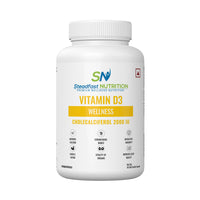Table of Content
Vitamin D also called the “sunshine vitamin” is synthesised by the body when the skin is exposed to sunlight. Vitamin D is a fat-soluble vitamin which has innumerable functions - it helps the body absorb calcium and phosphorous, strengthens bones, prevents involuntary contraction of muscles which may lead to cramps and spasms, boosts immunity, and plays an important role in neuromuscular function. Low levels of Vitamin D are directly linked to many health-related disorders such as osteomalacia in adults and rickets in children. Some other indicators of low levels of vitamin D in the body are fatigue increased sensitivity to pain, muscle ache and susceptibility to autoimmune disorders.
Types of Vitamin D
The human body can produce vitamin D in response to sunlight exposure. However, due to inadequate sun exposure, some individuals may need to increase intake through specific foods or supplements. There are two main types of Vitamin D in foods and dietary supplements: Vitamin D2 (ergocalciferol) which mainly comes from plants and Vitamin D3 (cholecalciferol) which is synthesised by the body on exposure to sunlight and can be sourced from animals such as fatty fish. Vitamin D3 is directly absorbed in the body and enhances vitamin D levels in the body much more than vitamin D2 due to its high bioavailability.
How much Vitamin D do you Need for Overall Wellbeing?
Vitamin D requirements can vary according to age, sex, and specific health conditions. Mentioned below is the recommended vitamin D dosage as per the recommended dietary allowance (RDA) as per NIN-ICMR for daily Vitamin D dosage to lead a healthy lifestyle and overall well-being.
- Adult men ( >18y): 600 IU/day
- Adult women (>18y): 600 IU/day
- Pregnant or lactating women: 600 IU/day
- Children (1-9y): 600 IU/day
- Infants (0-12 m): 400 IU/day
- Boys (10-18y): 600 IU/day
- Girls (10-18y): 600 IU/day
People deficient in Vitamin D may need higher doses, but it’s important to consult a healthcare professional before increasing your daily vitamin D intake.
What are the Good Sources of Vitamin D3?
Vitamin D3 can be obtained through a variety of sources such as:
- Sunlight: The most natural and effective way to get Vitamin D is through sun exposure. About 15-30 minutes of sun exposure on the skin a few times a week can help produce sufficient Vitamin D levels.
- Fatty Fish: Sardines, mackerel and Salmon, are some excellent sources of Vitamin D3.
- Red meat: beef, lamb, mutton, pork, and goat are also packed with Vitamin D3.
- Egg Yolks: Egg yolks contain moderate amounts of Vitamin D3.
- Fortified Foods: foods like milk, orange juice, and breakfast cereals are fortified with Vitamin D3.
- Supplements: For people who don’t get enough Vitamin D from sunlight or food, Steadfast Nutrition’s Vitamin D3 supplement which comes in the form of Vitamin D3 capsules, can be taken to maintain adequate levels of vitamin D3 and help prevent its deficiency.
How do you know if you have Vitamin D deficiency?
Vitamin D deficiency is mostly prevalent in individuals who have very little sun exposure on a daily, young children and adolescents (during rapid growth spurts), where it can lead to rickets (softening and weakening of bones); in the elderly, changes in vitamin D intake and/or physiological changes in vitamin D metabolism and hormonal changes may lead to osteomalacia and osteoporosis because of vitamin D deficiency during menopause.
Vitamin D deficiency can be subtle and may not be identified easily, but common symptoms include fatigue, muscle weakness, bone or joint pain, poor immunity and hormone imbalances. Thus, a blood test is required to measure the status of your Vitamin D levels.
Here’s a breakdown of the Vitamin D status based on nanograms per millilitre (ng/mL):
- Deficiency: 25(OH)D (25- hydroxyvitamin D) of < 20 ng/ml
- Insufficient: 25(OH)D (25- hydroxyvitamin D) of 21-29 ng/ml
Research suggests that maintaining a level of >30 ng/mL is optimal to maintain health and well-being in most people.
Who Needs More Vitamin D3?
Certain groups of people may require more Vitamin D due to specific factors such as lifestyle, age, or health conditions. Here’s a closer look at who needs more Vitamin D and why:
1. Urbanites with limited sun exposure:
People living in urban areas need more sunlight to accelerate vitamin D production but often don’t get enough of it due to factors like congested, window-less living spaces, long working hours due to corporate culture and limited access to sunlight due to pollution or high AQI. It may be harder to get enough Vitamin D3 through sun exposure alone, especially during the winter months. Moreover, people who cover themselves with layers of clothes or apply sunscreen on the skin while sunbathing may not receive enough vitamin D through sunlight.
2. People with certain medical conditions:
People with liver disease, obesity, diabetes, or gastrointestinal diseases may need vitamin D supplementation as their bodies might not absorb Vitamin D (a fat- soluble nutrient which relies on the gut’s ability to absorb fat) or use it effectively.
3. Elderly people:
Ageing makes our skin less efficient at producing Vitamin D from sunlight. Additionally, older adults are more prone to bone loss and fractures, which makes sufficient Vitamin D levels even more critical to preserve bone mass and maintain blood levels for optimal health.
4. People with darker skin tones:
Melanin is a pigment that gives colour to the skin and protects it from UV light. It also reduces the body’s ability to produce Vitamin D from sunlight. Thus, people with darker skin tones may need more sun exposure to maintain adequate Vitamin D levels.
5. People who follow a vegetarian or vegan diet:
Most animal sources, such as fatty fish, egg yolk, and liver, contain a natural form of vitamin D, while plant sources do not. That is why people with a vegan or vegetarian dietary pattern can take vitamin D supplements to prevent its deficiency.
How to Choose the Right Vitamin D Supplement?
Vitamin D supplements are available in various forms such as capsules, tablets and gummies. When choosing a Vitamin D supplement, it is essential to consider the form that works best for you as suggested by your healthcare provider that can be be incorporated into your routine.
Vitamin D3 capsules (cholecalciferol) are generally more effective at raising blood levels of Vitamin D than vitamin D2 (ergocalciferol). It is also important to note that vitamin D is efficiently absorbed by the body when taken with a meal or snack that contains some amounts of good fats. It is important to keep in mind that vitamin D3 supplements should be clinically tested and free from heavy metals to avoid health risks.
How much Vitamin D is too much for your body?
One of the major questions about vitamin D3 that people often wonder about remains, “How much vitamin D3 should I take daily?” Or “How much Vitamin D3 is required daily by the body to function properly?”
Any nutrient taken in excess is harmful to health and can lead to toxicity. Taking huge amounts of Vitamin D can lead to hypercalcemia (excess calcium in the blood which can cause weakness, nausea and kidney issues. Thus, it is advisable to consult a healthcare provider before starting a high dosage of Vitamin D in any form. The recommended dietary allowance (RDA) of Vitamin D for adults is 400-600 IU depending on age, sex and underlying medical conditions.
Conclusion
Several studies states that low levels of Vitamin D affect several physiological functions in the body and deteriorate the quality of life. It is important to maintain sufficient levels of vitamin D through adequate sun exposure, diet and supplements (if required). Positive outcomes are only possible through regularly monitoring your over all health and maintaining a healthy lifestyle. Thus, detection of vitamin D deficiency through regular checkups and consultations with your healthcare provider can aid in personalised, appropriate treatment at the right time.
FAQs
Can I get enough vitamin D from sunlight alone?
Spending a short amount of time, approximately 15 minutes for a person with light skin and around half an hour for a person with dark skin is sufficient sun exposure with minimal layers of clothes to produce adequate amounts of Vitamin D in the body.
What is the best time to take a vitamin D supplement?
There is no specific time mentioned for daily vitamin D intake, However, Vitamin D benefits can be best reaped when taken with meals containing good fats for better absorption.
Can too much vitamin D be harmful?
Even though vitamin D benefits are in abundance, taking too much Vitamin D can cause a condition called hypercalcemia (build-up of excess calcium in the body) which can lead to weak bones or kidney problems including kidney stones. Hence, it is advised to consult a health care professional before starting any new supplement or in case of Vitamin D toxicity due to high Vitamin D dosage.
Should I take vitamin D daily or weekly?
The frequency of Vitamin D dosage depends on individual body needs and dietary patterns. It is crucial to take a healthcare professional’s advice before taking vitamin D and ascertain whether it is required to be taken daily or weekly.
How do I know if I need a vitamin D supplement?
You can get an in-depth analysis of your Vitamin D levels through a blood test. The results would show if your vitamin levels are low and subsequently, your healthcare provider can recommend Vitamin D dosage according to your needs.


